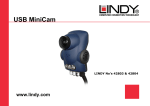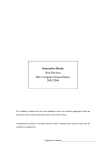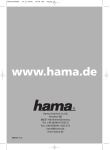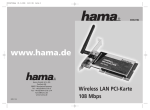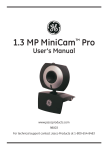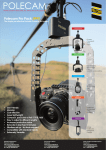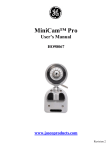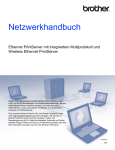Download Lindy USB MiniCam Digital Camera User Manual
Transcript
English Manual English Manual Introduction: The LINDY USB MiniCam is a high-resolution camera with audio support. A single cable connects the camera to your computers USB and MIC IN ports. Technical Specifications Sensor Max. Resolution: Supp. Resolutions: USB MiniCam User Manual Benutzerhandbuch English Deutsch Frame rate: Capture Resolution: Focus Distance: Lens angle: Colour Format: Power Consumption: 160mW Supported OS: Interface: 1/7” CMOS 640 x 480 640 x 480; 352 x 288; 176 x 144 and 160 x 120 Up to 30 @ 352 288, 35 @ 176 x 144 Up to 640 x 480 3cm - ∞ 56 degree 24 bit RGB Windows 98/2000/ME/XP USB 1.1 Full Speed Driver Installation You must install the USB MiniCam drivers before you connect the MiniCam to your computers USB port. 1. 2. 3. 4. 5. 6. 7. 8. 9. Insert the driver CD – the driver installation menu will be displayed automatically. Select ‘Driver Install’, the computer will run the driver installation process. The ‘Install Shield Wizard’ dialogue box will appear; click ‘Next’ and the installation will start. Select the necessary language and select OK. Follow the on-screen instructions to complete the installation procedure. Select ‘Finish’ when prompted to complete the installation. Click ‘Exit’ on the ‘Software Installer’ screen You MUST now reboot your computer. When your machine has rebooted, plug-in the LINDY USB MiniCam to the USB port. Windows will automatically detect the new hardware and configure the device. Note: If you are using Windows XP your system may display a ‘Driver Signature’ notification message, select ‘Continue Anyway’ to install the driver. Recording and capturing pictures For live recording: 1. Under ‘Amcap’ click ‘File’, select ‘Set capture File’, give a filename and save. The file will be stored as *.avi-file. 2. If you click ‘Capture’ and select Capture Audio’, then sound picked up by the cameras microphone will also be recorded. 3. Click ‘Set Frame Rate’ to change the frame rate. Select ’Use Frame Rate’ and click ‘OK’ to save the setting. 4. Under ‘Set Time Limit’ you may adjust the time period you want to record by setting the period in seconds, selecting ‘Use Time Limit ‘. 5. Click ‘Capture’ – ‘Start Capture’ to start recording and confirm by clicking ‘OK’ when the recording is finished. Capture one or several pictures 2. Under the ‘Start’ menu – ‘Programs’ - ‘Qcam’ select ‘VidCap’ to get the capture software. 3. To get the live camera picture, you have to click on this Button: 4. 5. For a single frame, click on the - Button, then click ‘File’ and select ‘Save Single Frame’ to name and store your picture file. If you want to capture several images subsequently, click on the 6. - Button By clicking this Button: , you may also capture a video sequence with the software. Preselect the compression mode and the frame rate and then click ‘OK’ to start the recording. Using the LINDY USB MiniCam together with Netmeeting® 1. 2. Adjusting the Picture Parameters The LINDY USB MiniCam picture parameters may be adjusted depending on your environment, and your requirements. 1. 2. LINDY Art.No. 32887 www.LINDY.com © LINDY ELECTRONICS LIMITED & LINDY-ELEKTRONIK GMBH - SECOND EDITION (Oct - 2003) 3. 4. From the Start menu open ‘Programs’ – ‘Qcam’ – ’AMCAP’ In the ‘options’ menu select ‘Video Capture Filter’ to enter the properties settings of the camera. You may adjust the following values: • Auto Exposure value • Anti-Flickering: According to your power frequency: 50 or 60Hz or none if you’re using the camera as an outdoor device. • Video output: Mirroring or vertical flip • Contrast, saturation and gamma correction • Sharpening, quality and brightness Click ‘Apply’ Select ‘Option’ and choose ‘Video Capture Pin’ to adjust the frame rate or colour mode. 3. 4. 5. After having installed the ‘QCam driver’, plug the camera into your computer’s USB port and start the Netmeeting program. If it is the first time that you start Netmeeting, a setup wizard program will run asking you for the properties, such as your name, your email address, connection speed etc. Under ‘Extra’ – ‘Options’ – ‘Video’ you can determine the video source, it should say ‘Q-CAM’! After having given that information to the setup program, click ‘Finish’ to complete the Netmeeting setup. Click the ‘Dial’-Icon and type in the IP address of the computer you want to connect to. ’Dial’-Icon IP-Address field Deutsches Benutzerhandbuch Einleitung Die LINDY USB MiniCam ist eine hochauflösende Kamera mit AudioFunktionalität, die über den USB-Port mit Ihrem Computer verbunden wird. Technische Sepzifikationen Sensor: 1/7“ CMOS Max. Auflösung: 480 x 640 Pixel Unterstütze Auflösungen: 640 x 480, 352 x 288, 176 x 144 und 160 x 120 Bildübertragungsrate: Bis zu 30 /s bei 352 x 288, bis zu 35 /s bei 176 x 144 Aufl. für Capture-Funktion: bis zu 640 x 480 Schärfentiefe: 3cm - ∞ Bildwinkel der Linse: 56 Grad Farbtiefe: RGB 24 Bit Leistungsaufnahme: 160mW Unterstütze Betriebssysteme: Windows 98SE / ME / 2000 / XP Schnittstelle: USB 1.1 Full Speed (12Mbit/s) Treiberinstallation 1. Booten Sie den Computer und stellen Sie sicher, dass Ihr USBPort richtig funktioniert. 2. Legen Sie die Treiber-CD ein – das Installationsmenu wird automatisch angezeigt. 3. Klicken Sie auf ‚QCam Driver’ , das System startet den Treiberinstallationsprozess. 4. Der ‚Install Shield Wizard erscheint nun, klicken Sie auf ‚Weiter’, um die eigentliche Installation zu starten. 5. Nach erfolgter Installation, wählen Sie ‚Computer neu starten’ und klicken Sie auf ‚Fertig stellen’, um die Installation zu komplettieren. Der Rechner bootet jetzt neu. 6. Schließen Sie nun die LINDY USB MiniCam an den USB-port an. Das System wird sie automatisch erkennen und konfigurieren. Einstellung der Bildparameter 1. Öffnen Sie im Startmenu ‚Programme’ – ‚QCam’ – ‚Amcap’ 2. Wählen Sie ‚Video Capture Filter’ im Menu ‚Options’, um die Einstellungen der Kamera zu editieren. Die folgenden Werte können eingstellt werden: • Vollautomatische Bildeinstellung an/aus • ‚Anti-Flickering’: je nachdem, welche Netzfrequenz verwendet wird, kann dieser Wert auf 50 Hz, 60Hz gesetzt werden, um das Flimmern des Bildes zu unterdrücken. ‚None’ sollte gewählt werden, wenn die Kamera im Freien verwendet wird. • ‚Video output’: Abhängig von der Montageposition der Kamera kann hier ‚mirroring’ für spiegelverkehrte, und ‚vertical flip’ für um 180 ° gedrehte Bildausgabe eingestellt werden. • Kontrast, Farbsättigung (‚Saturation’) und Gammakorrektur • Bildschärfe, Qualität und Helligkeit. 3. Klicken Sie ‚Apply’ 4. Unter ‚Option’ wählen Sie ‚Video Capture Pin’ um die Bildübertragungsrate und den Farbmodus zu justieren. Deutsches Benutzerhandbuch Aufnahme 1. Unter ‚Startmenu’ ‚Programme’ – ‚QCam’ – ‚Amcap’ wählen Sie ‚File’ und klicken auf ‚Set Capture File’, vergeben einen Dateinamen und speichern. Die Datei wird im avi-Format gesichert. 2. Wählen Sie ‚CaptureAudio’ unter ‚Capture’, um das Audiosignal mit aufzunehmen. 3. Klicken Sie auf ‚Set Frame Rate’ und justieren Sie die Bildwiederholungsrate. Markieren Sie ‚Use Frame Rate’ und klicken Sie auf ‚OK’, um die Einstellung zu sichern 4. Unter ‚Set Time Limit kann die gewünschte Aufnahmelänge in Sekunden gesetzt werden. Markieren Sie ‚Use Time Limit’ und klicken Sie auf ‚OK’, um die Einstellung zu sichern 5. Klicken Sie auf ‚Capture’ – ‚Start Capture’, um die Aufnahme zu starten und Bestätigen Sie durch einen Klick auf ‚OK’ wenn die Aufnahme beendet ist. Aufnahme eines oder mehrerer Einzelbilder 1. Mit einem Klick auf ‚VidCap’ unter ‚Start’ – ‚Programme’ – ‚QCam’ wählen Sie die Software für Einzelbildaufnahme an. 2. Um das ‚Live’-Bild der Kamera zu sehen, klicken Sie auf 3. . diesen Button: Um ein Einzelbild aufzunehmen, klicken Sie auf diesen 4. , danach auf ‘File’ und ‘Save Single Frame’ um Button: die Bilddatei zu benennen und zu sichern. Wenn Sie mehrere Einzelbilder hintereinander aufnehmen wollen, klicken Sie auf dieses Feld: 5. können mit dieser Durch Anklicken dieses Feldes: Software ebenfalls Videosequenzen aufgenommen werden. Wählen Sie den Kompressionsmodus und die Bildübertragungsrate vor, und klicken Sie auf ‚OK’ um die Aufnahme zu starten. Verwendung der MiniCam mit Netmeeting® 1. Nachdem die ‚QCam-Treiber installiert sind, verbinden Sie die Kamera mit dem USB-Port und starten Netmeeting. 2. Beim ersten Start von Netmeeting läuft ein Installationsassistent, der die notwendigen Einstellungen ( Name, Email-Adreesse, etc.) abfragt. 3. Nachdem diese Informationen hinterlegt wurden, klicken sie auf ‚Fertig stellen’ um das Setup abzuschließen. 4. Unter ‚Extras’, ‚Optionen’ – ‚Video’ kann die Aufnahmequelle festgelegt werden – hier sollte ‚QCam’ stehen. 5. Klicken Sie auf das ‚Anwahl’-Icon, und geben Sie die IP-Adresse des Rechners ein, den sie anwählen wollen. Radio Frequency Energy, Certifications Shielded cables must be used with this equipment to maintain compliance with radio frequency energy emission regulations and ensure a suitably high level of immunity to electromagnetic disturbances. FCC Compliance Statement (United States) This equipment has been tested and found to comply with part 15 of FCC rules. Operation is subject to the following two conditions: (1) This device may not cause harmful interference. (2) This device must accept any interference received. Including interference that may cause undesired operation. Canadian Department of Communications RFI statement This equipment does not exceed the class B limits for radio noise emissions from digital apparatus set out in the radio interference regulations of the Canadian Department of Communications. Le présent appareil numérique n’émet pas de bruits radioélectriques dépassant les limites applicables aux appareils numériques de la classe A prescrites dans le règlement sur le brouillage radioélectriques publié par le ministère des Communications du Canada European EMC directive 89/336/EE CE statement This equipment complies with the requirement for CE mentioned in the European Directive and Standards EN55022 and EN55024. This equipment has been tested and found to comply with the limits (for a class B computing device) in accordance with the specifications in the European Standard EN55022. These limits are designed to provide reasonable protection against harmful interference. This equipment generates, uses and can radiate radio frequency energy and if not installed and used in accordance with the instructions may cause harmful interference to radio or television reception. However, there is no guarantee that harmful interference will not occur in a particular installation. If this equipment does cause interference to radio or television reception, which can be determined by turning the equipment on and off, the user is encouraged to correct the interference with one or more of the following measures: (a) Reorient or relocate the receiving antenna. (b) Increase the separation between the equipment and the receiver. (c) Connect the equipment to an outlet on a circuit different from that to which the receiver is connected. (d) Consult the supplier or an experienced radio / TV technician for help. Anwahl-Icon IP-Adressfeld © LINDY ELECTRONICS LIMITED & LINDY-ELEKTRONIK GMBH - SECOND EDITION (Oct - 2003)


